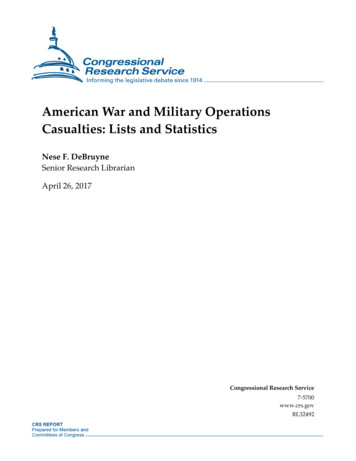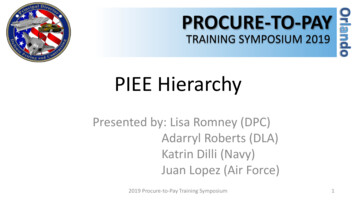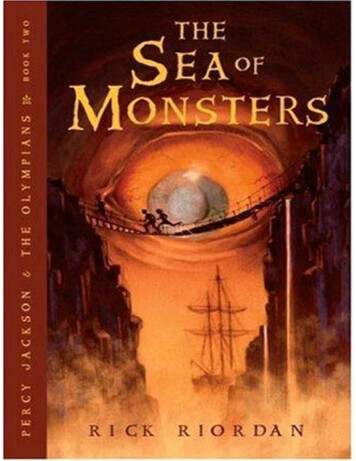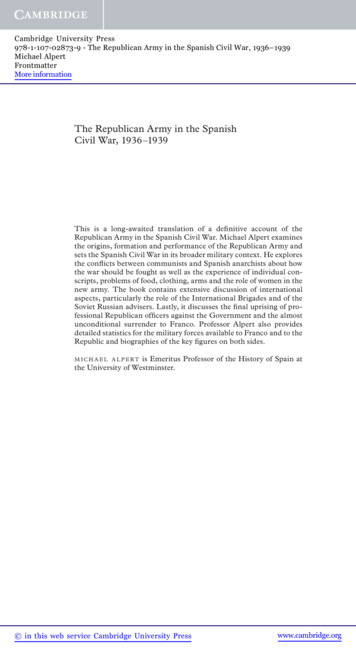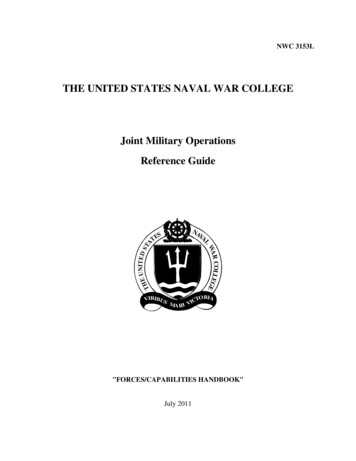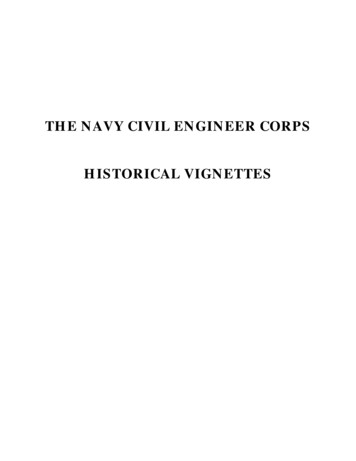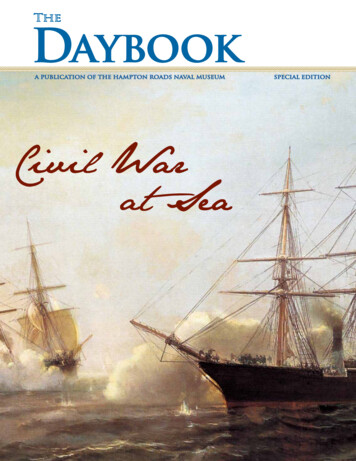
Transcription
DaybookA PUBLICATION OF THE HAMPTON ROADS NAVAL MUSEUMCivil Warat SeaSPECIAL EDITION
TheDaybookT Civil War Navy Special Editionhe American Civil War has been studied and interpreted from manydifferent angles to include its political causes and ultimate effects on Americansociety, the War’s great leaders, and of course, its armies. With the exclusionof the famous battle of the Monitor versus Virginia that every student learnsabout, naval engagements are notably lacking in Civil Warhistories.The naval aspect of the war was as important to the war’sconduct and outcome as any ground campaign. Despiteongoing advances in transportation technology, the majorityof men and materiel moved by water. He who controlledAmerica’s waterways would win the war.This naval war was directed by two men: Gideon Welles, the24th U.S. Secretary of the Navy, and Stephen Mallory, theConfederate States of America’s Secretary of the Navy. Bothleaders faced an impossible task. Welles had to transform apeacetime flotilla of fifty decrepit ships into a global fightingforce capable of patrolling and controlling thousands of milesof coastline and rivers. Mallory did not even have a navy, yet he had to stave offthe U.S. fleet, all the while maintaining a steady flow of supplies from Europe tosupply a Confederate Army.Some of the brightest minds and bravest souls this country had to offer ablyassisted both Secretaries. The naval battles they fought ultimately determinedthe war’s timeline and course.The Daybook is a registered trademark of the Hampton Roads Naval Museum (HRNM), Department of theNavy, an agency of the United States Government. It is an authorized publication of HRNM. Its contents donot necessarily reflect the official view of the U.S. Government, the Department of Defense, the U.S. Navy,or the U.S. Marine Corps and do not imply endorsement thereof. Book reviews are solely the opinion of thereviewer.The HRNM reports to the Naval History and Heritage Command, Museums Division (www.history.navy.mil). The museum is dedicated to the study of 235 years of naval history in the Hampton Roads region.HRNM was accredited by the American Association of Museums in 2008.The Daybook’s purpose is to educate and inform readers on historical topics and museum related events.It is written by staff and volunteers.Direct questions or comments to the Hampton Roads Naval Museum editor. The Daybook can be reachedat 757-322-2993, by fax at 757-445-1867, e-mail at gordon.b.calhoun@navy.mil or write The Daybook,Hampton Roads Naval Museum, One Waterside Drive, Suite 248, Norfolk, VA 23510-1607. The museum ison the World Wide Web at http://www.hrnm.navy.mil.The Daybook is published quarterly. To subscribe, contact the Hampton Roads Naval Historical Foundationat (757) 445-9932 or visit http://www.hrnhf.org. To learn more about the naval side of the Civil War, visitwww.civilwarnavy150.blogspot.com.
theDAYBOOKTSpecial EditionWelcomehe Sesquicentennial of the American Civil Waris near, and the U.S. Naval History and HeritageCommand has appointed the Hampton Roads Naval Museum asthe lead agent for its commemoration. We devote this issue of The Daybookto that effort. Three essential aspects of naval warfare are addressed herein:the Northern blockade of Southern ports; the riverine front; and the Confederate cruiser attacks on Union merchant ships.Interspersed in the articles that follow are the men, their vessels and the operations that made the Civil War the mosttraumatic and defining conflict in American History.We turn first to the Northern blockade of Southern ports. The vast majority of America’s manufacturing capacity waslocated in Northern states. There were a few industrial centers in the South, but not nearly enough to sustain a large fieldarmy. The Confederacy needed European factories. President Abraham Lincoln was determined in 1861 to prevent thataccess, and proclaimed the Southern ports were to be a state of blockage. During the entire course of the war, a dailychess match occurred between the blockaders and the crafty blockade runners. This slow grind was interceded by large,dramatic battles as the U.S. Navy moved to permanently shut down key Southern ports.The second naval linchpin was found in America’s rivers. While the 19th century saw great improvement in groundtransportation technology, the vast majority of people and goods moved by river. With the notable exception of Atlanta,all of the major urban areas in the South were located on a major river. Lincoln knew that in order to subdue theConfederacy, the Union must gain control of the interior waterways. A series of violent encounters occurred betweenU.S. Navy and Army gunboats and Confederate fortifications.The Confederate cruiser attacks played out on the highseas in a world-wide campaign to hunt down U.S.- flaggedmerchant ships. Though small in number, the Confederateships did an extreme amount of damage. Part of that damagewas intended to be propaganda in nature, to wear downNorthern support for the war. A specific Northern voting blocof wealthy entrepreneurs, whose ships and goods were beingtaken, could easily see the war was detrimental to business.A wealth of information exists on these topics; this issueprovides but an overview. Future issues of The Daybook willdelve into Hampton Roads - specific topics. We are seekingscholars willing to write original pieces for future issues. Wewill keep readers up to date about the Civil War at Sea on ourblog civilwarnavy150blogspot.com. You may also call us.Becky PoulliotDirector(757) 322-2990Gordon CalhounHistorian(757) 322-29932
theDAYBOOKSpecial EditionPart I - The BlockadeThe U.S. Navy patrols 3,000 miles of coastlinein search of Confederate blockade runners3
theSpecial EditionDAYBOOKNaval paymaster William Keelerwas enjoying a June afternoon fishingoff Wilmington, North Carolina in 1863,catching “hundreds of the finest blackfish.”His sport was interrupted when the cry “SailHo” roused Keeler and his fellow shipmatesof the blockade ship USS Florida. Floridabecame suspicious of the strange sail, andreceived permission to give chase.Keller describes the efforts of the ship’screw to get maximum power from the steamengines: “Oil, grease and pitch were freelyused in our furnaces & it was difficult to sayfrom whose pipe issued the blackest smoke.Every sail that would draw was set & everyexertion made to bring our vessel up to herhighest possible speed & keep her there.”The ship’s gunners stood ready and whenthe stranger was in range “our first shot torehowling through the air we knew that shewas ours.” The blockade runner Calypsosoon become Union propertyThe capture of Calypso is but oneepisode in an ongoing drama that occupiedthe U.S. Navy from the first shots of the warin April 1861 until the guns fell silent in1865: the naval blockade of the Confederacy.This enormous effort involved thousands ofmiles of coastline, hundreds of vessels and alevel of strategic and tactical planning thatthe Navy had never attempted. AdmiralDavid Dixon Porter went so far as to writethat “taking into consideration the extent ofthe coast that had to be blockaded, and theshort time in which it was all accomplished,the work can scarcely be comprehended bythe ordinary mind ”The blockade was announced from thehighest level of the government: PresidentAbraham Lincoln declared it on April 19,1861 (a few days after Fort Sumter). Theidea, really a very old naval strategy, wasmentioned the month before in a memo fromArmy Lieutenant General Winfield Scott.Scott had seen naval power used to effect bythe British in the War of 1812 (of which hewas a veteran) and by the United States inthe Mexican War (in which he commandedland forces).In March 1861 Scott advocated a navalblockade as a way to avoid the “enormouswaste of human life.” In May of that year, ina famous letter to the young Union GeneralGeorge McClellan, Scott continued hisadvocacy of a blockade, and recommended itas part of a grand Union strategy. He wrote:“We rely greatly on the sure operation of acomplete blockade of the Atlantic and Gulfports soon to commence. In connection“A parcel of cats watching a big rat hole,” is the way one U.S. Naval officer described blockade duty. Thisdramatic image of a U.S. Naval gun crew chasing a blockade runner in the rain was played out hundreds oftimes throughout the war. (HRNM image)1861 - Chase of a Blockade RunnerThis Harper’s Weekly engraving of a U.S. Naval gun crew preparing to take a shot at a ship on the horizonwas a scene that was played out thousands of times throughout the war along America’s coastlines. Ablockading ship would patrol for days without seeing a thing, only to be called into action when a blockaderunner attempted to evade. (HRNM image)with such blockade we propose a powerfulmovement down the Mississippi to theocean, with a cordon of posts at properpoints the object being to clear out andkeep open this great line of communicationin connection with the strict blockade ofthe seaboard, so as to envelop the insurgentStates and bring them to terms with lessbloodshed than by any other plan.”The plan proposed the slow economicstrangulation of the Southern states, as if byguide Union grand strategy.At the beginning of the war, the UnitedStates Navy was too small to mount aserious blockade of the southern coast. TheSecretary of Navy Gideon Welles beganhis enormous task of obtaining ships forthe service. At first, Navy ships steamedsouth to take up positions off southernports, but historian Craig Symonds pointedout that “there was little system or order tothe deployment.” Symonds further quotes1861 - War is Good For BusinessThis is a stock certificate for the Charleston Importing and Exporting Company, one of theleading blockade running outfits. While there was a patriotic motivation to blockade running,many Southerners realized there was a huge amount of money to be made in bringing goods intoSouthern ports during the war. (Museum of the Confederacy image)a giant snake. Therefore, it quickly acquiredthe name “Anaconda.” Scott’s hope thatits application would avoid bloodshed waswrong, but the concept of blockading theConfederacy, while splitting it in two, did4the President’s own fear that “we could notmake the blockade of all the Ports effectual.”The Chief Executive had reason toworry. The blockade was not only aninstrument of war; it was a recognized
theSpecial EditionDAYBOOKVoices From the War1861 - A Blockade Buster is BornConfederate Secretary of the Navy Stephen Mallory, RichmondThe frigate Merrimac has been raised and docked at an expense of 6,000, and the necessary repairs tohull and machinery to place her in her former condition is estimated by experts at 450,000. The vesselwould then be in the river, and by the blockade of the enemy’s fleets and batteries rendered comparativelyuseless. It has, therefore, been determined to shield her completely with three-inch iron, placed at suchangles as to render her ball-proof, to complete her on the earliest moment, to arm her with the heaviestordnance, and to send her at once against the enemy’s fleet. It is believed that thus prepared she will be able to contendsuccessfully against the heaviest of the enemy’s ships, and to drive them from Hampton Roads and the ports of Virginia.element in the complex web of nineteenthcentury treaty diplomacy. The Confederategovernment pinned its hopes for ultimateindependence on the support of Europe. TheLincoln administration worked tirelesslyagainst any possible European intervention.The problem was two-fold for theUnion: first, a blockade had to be effectiveto be recognized under international law.Historian Rowena Reed states that “TheBritish, worried about their textile industry,were actively searching for evidence that theproclaimed blockade was ineffective. It wastherefore unmistakably impressed upon theSecretary of the Navy that it was governmentpolicy to strengthen the blockade and that theNavy’s first (and for the moment only) dutywas to enforce this policy.” Secondly, didthe concept of a blockade allow for the ideathat the Confederacy was an independentnation, and not a rebellious section of theUnited States? There was never a goodanswer to this question.Thankfully for the Navy, its sailors didnot have to wrestle with this diplomaticquestion. They had to put to sea. Somein the Navy had a ready understandingof the blockade’s purpose. Rear AdmiralTheodorus Bailey, Commander, East GulfCoast Squadron, possibly summed it up bestwhen he wrote, “The outward pressure of ourNavy, in barring the enemy’s ports, cripplingtheir power, and exhausting the resourcesof the States in rebellion; in depriving themof a market for their particular productions,and of the facilities for importing manyvital requisites for the use of their Armyand peoples, is slowly, surely reducingthe rebellion to unconditional surrender.”Other naval officers could not be botheredwith Bailey’s grasp of grand strategy - theyrequired a plan of action.In a remarkable development, this planof action came from four men meeting in amuseum during a hot Washington summer.Alexander Dallas Bache, superintendent ofthe Coast Survey, and Assistant Secretary of1862 - Breaking the Blockade IMallory had envisioned not only building swift ships to evade the blockade, but iron ships break it in two.The first serious attempt to break the blockade came when the ironclad CSS Virginia sortied into HamptonRoads on March 8, 1862 and attacked (upper image). The U.S. Navy countered the Confederate ironcladswith innovative ironclads of their own like USS Monitor, which dueled with Virginia on March 9 (lowerimage). (HRNM images)the Navy Gustavus Fox quickly agreed onthe need to plan and the “Blockade Board”(also known as the “Strategy Board”)came together. Throughout the summerof 1861, the Board met almost daily at theSmithsonian Institution. Their resultingsix reports comprised an exhaustive surveyof the Atlantic and Gulf coasts. Civil War5naval historian Stephen Taaffe summarizesthe importance of the Board’s work:“Fortunately, the Strategy Board offered anumber of solutions to seemingly intractableproblems that ultimately found their wayinto the Union Navy’s strategic plans. TheStrategy Board called for the occupationof isolated Confederate harbors that could
theDAYBOOKSpecial Edition1862 - Breaking the Blockade IIEight months after CSS Virginia put fear into the heart of the U.S. Navy, the ironclads CSS Palmetto State and Chicora found the blockade off Charleston ina weakened state and attacked. For a short time, the blockade was lifted before reinforcements arrived. (NHHC image)specially designed steamships constructed they wanted to run away from the U.S. Navy,expressively for speed usually displaced not fight it. In fact, if properly registered,between 400 and 600 tons. Most often their activity was not illegal.built of iron or steel, theysat low in the water, had Voices From the Warextremely narrow beams, and1863 - One Day on the Blockaderaking designs In manycases they carried only a light Log Book, USS Niphon, Cape Fearpair of lower masts, with noNovember 9 - At 12:25 a.m., being to the northwardyards. the hull showed of Big Hill, saw a blockade runner [either Flora IIlittle above the water and or Syren] close to the beach. Gave chase and beatwas usually painted dull grey to quarters. Running along the beach at full speed,to camouflage the vessel. sending up rockets all the time. Fire was opened fromUnder certain stages of the Fort Fisher. Stood to the north and beat the retreat.moon and atmosphere, theAt 5:25 a.m. Saw a steamer [Ellia & Annie] to theblockade runners were almost northward, coming down the coast. Gave chase andinvisible at even 100 yards beat to quarters. At 5:30 a.m, opened fire upon theand blended so perfectly with steamer. She now stood directly for us at full speed,their surroundings that on evidently with the intention of running us down. Thedark nights only their wakes helm was put hard astarboard, all the starboardcould be seen as they steamed guns were fired directly into her, and the vessels wereby.”brought side by side, coming in collision at the bows.Blockade running was At the moment of collision the steamer was boarded,hugely profitable, if over- carried, and hawser hove on board and made fast.romanticized. The false In five minutes from the time of firing, she was in ourveneer of the dashing runner possession and a prize.culminated in Gone withThe runners did their job well. Blockadethe Wind’s Rhett Butler.Blockade runners were generally unarmed- runner historian Stephen Wise has estimatedthat 1,000 out of some 1,300 attempts to runthe blockade were successful. They broughtto the Confederacy weapons, ordnance,medical supplies, and luxury goods that madethe hazardous trips especially profitable.The Confederate government in 1864ushered in strict new regulations that, amongother things, banned the import of alcohol,and imposed fixed rates for the inward run.This law was posted on the books too latein the war to be of any real use.1863 - The Most Important Ship to the ConfederacyThis is the blockade runner Denbigh, one of the most successful blockade runners of the war. Launched inThe Union recognized and1863, the ship made thirteen round trip runs through the blockade and was captured only after running hardacknowledged the persistent victories of theaground near Galveston, Texas. With a low, sleek profile, Denbigh is an example of a typical blockade runnerblockade runners. One angry citizen wrotethat started to come on line in 1862. Because of ships like this, was the Confederate Army received necessaryto the Navy in 1861, “Why can not thosesupplies to keep fighting. (HRNM image)be easily seized, held and converted intologistical bases. Doing so would not onlyextend the amount of time Union warshipscould remain on their blockading stations,but it would also mean one less harbor forthe Navy to watch.”One hundred miles to the South, theConfederate government considered theblockade. Breaking it was the top priorityfor the Confederacy’s Secretary of the NavyStephen Mallory, who knew that the Southcould never equal the U.S. Navy’s numberof ships. As historian Stephen Tuckerwrote, Mallory turned to “a few powerful,technologically advanced ironclad vessels,armed with large powerful rifled guns.”These ironclads emerged periodically tothreaten Union fleets, most spectacularly atHampton Roads in 1862. However, none ofthese Confederate efforts resulted in freeinga Southern port. They remained spectacularfailures.The Confederacy did penetrate theblockade with stealth, as a fleet of blockaderunners began a procession of successfulmissions, mainly from the Bahamas andBermuda. Historian Robert Browningdescribed the technological edge thatblockade runners possessed: “These new,6
theSpecial EditionDAYBOOKports be blockaded? God knows there aresteamers enough in this country – guns, menand materials to close them up as tight as abottle.” The Navy concurred. Flag OfficerSilas Stringham wrote, “The accounts whichwe get of intercourse at different portsand inlets on the coast of North Carolinaalarm our commercial community andcause embarrassment and distrust to theDepartment.”Two years later, Rear Admiral S.P. Leegave no indication that things had improved.He commented that “swift and suitablearmed steamers are needed to capture theblockade runners. The blockade requiresmore and better vessels and must eventuallyfail without them.” Lee was inclined to bepessimistic, a quality which made it easy forthe Navy to push him aside for more positiveleadership. But there was no denying thatmost blockade runners made port.No doubt the daily tedium of blockadeduty wore on the Navy and contributedto the failure to corral the sleek runners.Paymaster Keeler tried to convey the mentalstrain in a letter to his wife: “Here we are1862 - 1863 Assaults From the SeaThe best way to enforce the blockade was to capture the ports from which the blockade runners called home.Taking the ports required cooperation between the U.S. Army and Navy. Sometimes joint operations wentsmoothly such as the 1862 Battle of Roanoke Island (at left) in North Carolina. But often it did not, such asthe siege of Charleston (at right) where senior U.S. Army and Naval officers often bickered and blamed eachother for numerous failures. (HRNM images)dear Anna, on ‘our Station’ and here we arelike to be for, I don’t know how long Itis to be one dull monotonous round, dayafter day, week after week, yes month aftermonth, for expect to count the time here by1863 - The WatcherWhen the U.S. Navy began their rapid expansionof the fleet in 1861, the vast majority of the vesselswere small steamers with good speed, not largecapital ships. One example is the USS Niphon(right) a 600-ton, iron hulled ship, originallydesigned for the coastal China trade. Niphoncaptured eight blockade runners from 1863 to 1865.(NHHC image)months. No papers, no letters, no news,‘no nothing.’ The latest fashions, the lastgreat murder or railroad accident we regardwith the same stoical indifference.” It didnot help, as historian Rowena Reed wrote,that “the thankless job of chasing elusiveblockade runners could hardly comparewith the more glamorous task of capturingBeaufort or Norfolk.”Yet these more glamorous taskswere also part of the blockade, as theystemmed directly from the BlockadeBoard’s recommendations to establishlogistical bases on the Southern coastline,and the logical extension of that idea, theVoices From the War1863 - The Yankee Ironclads AttackMajor William Echols, CSA, Fort SumterThey steamed up main Ship Channel toward Fort Moultrie in lines of battleas follows: Four single turrets, Ironsides, three single turrets, and Keokuk,following one after the other at intervals of about 300 yards. When within 2,200yards, Fort Moultrie fired the first gun.The first turret opened fire at five minutes past 3 and moved backwards, thusdeveloping their maneuver of attack. At this moment the engagement became general.The second turret passed the first, fired, moved backward.The Ironsides, when at 1,700 yards from Fort Moultrie and 2,000 yards from Sumter, stopped, discharged a battery at the former,when Sumter concentrated a heavy fire upon her. Numbers of shot were seen to strike her and several to penetrate, three, at least,in her wooden stern.The Keokuk, at five minutes past 4, defiantly turning her prow directly toward Sumter, firing from her forward turret gun, thebatteries of Sumter, Moultrie, Bee, and Cumming’s Point were concentrated upon her. Within 900 yards she was struck, supposedby a wrought-iron bolt, 117 pounds, from a 7-inch Brooke rifle, en barbette, near her bow, penetrating and ripping up a platingabout 6 feet long and 2 1/2 wide, which ended her career.She sank off the south end of Morris Island at half past 8 o’clock the following morning. From her wreck floated ashore a book,a spyglass, and piecs of furniture bespattered with blood and small fragments of iron sticking in them.7
theDAYBOOKSpecial EditionVoices From the War1864 - Damn the TorpedoesFoxhall Alexander Parker, Mobile BayBeholding the disaster to the Tecumseh, the Brooklyn stopped. "What is the matter with theBrooklyn?" asked the admiral, anxiously, "Freeman, she must have plenty of water there.""Plenty of water, and to spare, admiral," replied the sturdy pilot; " but her screw is moving:I think she is going ahead again, sir."The enemy, not slow to comprehend this condition of affairs, take advantage of their opportunity,and, manning all the guns from which they have so recently been driven, pour in a murderous fireupon our fleet, which meets with but a feeble fire in return."At this critical moment," writes an eye-witness, "the batteries of our ships were almost silent, whilethe whole of Mobile Point was a living line of flame." The slightest vacillation then on the part of theadmiral, and the battle would have been lost, and the greater part of the fleet destroyed.Then was made manifest the soundness of the admiral's judgment in lashing his vessels together bypairs; for the Hartford going ahead, while the Metacomet backed, the bows of the former were swung to the westward, until clearof the Brooklyn's stern, when both vessels gathered headway. As they were slowly passing the Brooklyn, her captain reported "aheavy line of torpedoes across the channel.""Damn the torpedoes!" was the emphatic reply of Farragut. "Jouett, full speed! Four bells, Captain Drayton." And the Hartford,as if eager to bear the admiral's flag to the front, bounded forward " like a thing of life," and, increasing her speed at each instant,crossed both lines of torpedoes, going over the ground at the rate of nine miles an hour; for so far had she drifted to the northwardand westward while her engines were stopped, as to make it impossible for the admiral, without heading directly on to FortMorgan, to obey his own instructions to "pass eastward of the easternmost buoy."As soon as he could get his vessel's head to the northward, Alden, the captain of the Brooklyn, "pushed up the channel at fullspeed, in the Hartford's wake," and, during the fight which ensued with the Confederate ram, displayed his usual gallantry. A goodseaman, a skilful officer, whose battle-record attests his bravery, his hesitancy at " Mobile's Gate " must needs be ascribed to anerror of judgment, since all will admit that in many a stubborn fight elsewhere he served the Republic well.1864 - Medal of Honor1864 - The Anaconda TightensAdmiral David Glasgow Farragut led a combined squadron of wooden steam sloops, gunboats, and ironcladmonitors into Mobile Bay. The victory shut the Gulf of Mexico off to blockade runners. (NHHC image)seizure of Confederate ports. The Southerncoast was thousands of miles long, but formilitary value it was not all of one piece.The blockade required steamships, whichrequired coal, which required coalingstations. Thus, the U.S. Navy proceeded toexecute a series of hammer blows landing onsouthern ports: Hatteras and North CarolinaSounds (1861); Port Royal, South Carolina(1861); New Bern, North Carolina (1862);Norfolk (1862); New Orleans (1862); andso on. The Confederates never mounted aneffective response to these incursions andwere lucky that the Union did not exploit thecaptures of the ports to their fullest militaryadvantage. The slaughter of the great landbattles continued.While it did, the Navy was steadilybuilding to a size undreamed of in theservice’s history – eventually more than8John Lawson was one of nearly 20,000 AfricanAmericans who enlisted in the U.S. Navy during theAmerican Civil War. While they were restricted inrate, African American sailors served with greatdistinction throughout the war. Lawson earnedthe Medal of Honor for courageous acts under fireduring the Battle of Mobile Bay while serving as anordnance handler on USS Hartford. Lawson wasone of eight African American sailors to receiveAmerica’s highest military honor during the war.(NHHC image)600 ships flew the Union jack. No one inEurope opined any more that the blockadewas not real. For perceptive observers, theembarrassment of the blockade runners wasbeside the point. They were steaming intothe South one small ship at a time. What wascoming out? The answer was very little.Craig Symonds explained the key, anderroneous, assumption of the Confederategovernment: “From the beginning of the
theDAYBOOKSpecial Edition1865 - The Anaconda StranglesWith over 600 guns deployed at sea, 10,000 of Grant’s veterans, and 2,000 of his own sailors andmarines, Rear Admiral David Dixon Porter captured Fort Fisher, the South’s last major coastal fort, inJanuary. With the victory, the blockade finally achieved its goal of cutting the Confederacy off from theoutside world. (HRNM image)war, Confederate officials had insistedthat cotton was their secret weapon. Theworld’s need for cotton was so great, theybelieved, that lack of it would compel thepowers of Europe to support the Southernbid for independence. By the time Southernlawmakers had realized their error, theblockade had become more efficient and theopportunity was lost. Fat bales of cotton,piled up on the wharves of Charleston,Galveston, and Mobile.” Assistant SecretaryGustavus Fox told President Lincoln’sprivate secretary that the rebellion wassustained “not by what entereth into theirports but by what proceedeth out.” Withoutcotton exports the Confederate economyhastened to an inevitable collapse.U.S. Naval commanders also changedtactics to make the blockade more effective.Commanders urged the Navy to obtainvessels of light draft to cross sand barsand speedy vessels to pursue blockaders asthey fled to open waters. Transport colliersallowed blockading ships to stay on station.As the war continued, Wilmington,North Carolina became the most importantremaining port in the Confederacy, as acombination of natural geography and thepowerful guns of Fort Fisher allowed itto remain open to blockade runners. Thetown took on a ‘Wild West’ atmosphere oflawlessness in the light of the freewheelingactivity associated with the running of theblockade (and the influx of luxury goodsand alcohol). Secretary of the Navy GideonWelles told Lieutenant General Ulysses S.Grant that, from a military point of view,Wilmington was more important thanRichmond. Grant subsequently committedtroops to subdue Fort Fisher, and the fallof that bastion was the final cinch in theblockading noose.How effective was the blockade? ForRear Admiral David Dixon Porter, thatwas really no question at all: “the systemof blockade resorted to is unparalleled inthe naval records of the world proofs ofits efficiency were so comprehensive andconclusive that no objections to it could bemade.” Other writers have not been so sure,and the debate continues among historiansto this day.It is true that as the war went on, theblockade tightened, and it had an effecton the
society, the War's great leaders, and of course, its armies. With the exclusion of the famous battle of the Monitor versus Virginia that every student learns about, naval engagements are notably lacking in Civil War histories. The naval aspect of the war was as important to the war's conduct and outcome as any ground campaign. Despite

